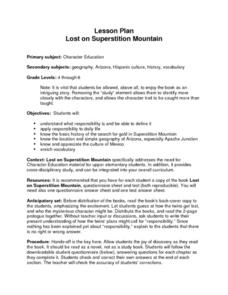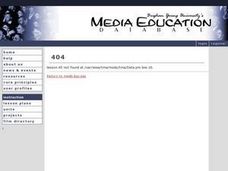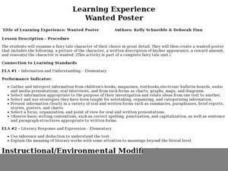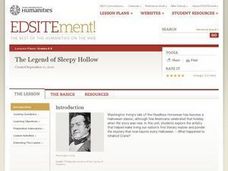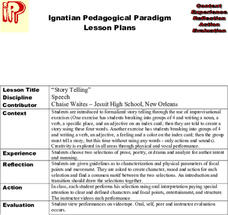Curated OER
Date with Responsibility
Students discuss what it means to be responsible. As a class, they brainstorm a list of how they are responsible in their daily lives. In groups, they read the story of Liliuokalani and locate Hawai'i on a map. They discuss the...
Curated OER
Lost on Superstition Mountain
Students review the concept of responsbility and relate it to the own lives. Using the internet, they research the search for gold on Superstition Mountain in Arizona and locate it on a map. They also examine the culture of Mexico and...
Curated OER
Passport to Courage
Students discuss the character trait of "courage of convictions" and apply this to their daily life. Using the internet, they research the life and work of Thomas McKean and discuss the courage needed to sign the Declaration of...
Curated OER
Lesson 1: Theatre Arts
Students create and perform based on cuttings from various plays and literature to demonstrate the learning of the process of improvisation. Students connect improvisation with theatre and real life. Students participate in a class...
Curated OER
The Milkman
Students practice speaking and listening in the context of an improvised mini-play. They play the role of a milkman. He stops and rings the imaginary doorbell of one of the pupils. A conversation follows, for example: "What will it be...
Curated OER
Animation
Students explore the field of animation to describe characters and express opinions. They view pictures of cartoon characters, clips of British animation, and read about the making of Valiant. They design their own cartoon character...
Curated OER
The Lion, The Witch, and The Wardrobe: A Literature Evaluation Project
Sixth graders read and analyze The Lion, The Witch, and The Wardrobe. They study the elements of literature found in the book. Students create an elements of literature flip book that shows the various elements of literature in the novel.
Curated OER
Narrative Strategies
Sixth graders explore strategies authors use to make characters and setting seem real to readers. They develop characters and describe setting in original narratives. Students read myths and determine common themes found in myths from...
Curated OER
Number the Stars Chapter 16
Young scholars consider information about the character Peter, in the book Number the Stars. They discuss the author's use of withholding information about characters in her book. They discuss the issues of theme and climax within the book.
Curated OER
Unconditional Kindness
Students express their feelings about their neighbors and how to be kind to others. Teacher and students discuss the meaning of philanthropy and how they can be kind to others. After reading a particular trade book, students are assessed...
Curated OER
Crossroads Cafe: "Who's the Boss?" Act 1
Learners pronounce key phrases during a story. They discuss the story setting and the roles of the characters. They explain the problems the main characters face.
Curated OER
Story Stew -- Teaching Character, Plot, And Setting
Students examine the story elements of characters, plot, and setting. They identify the story elements from various "ingredients" taken out of a pot, and add their own story element "ingredients" on index cards into the pot.
Curated OER
Philanthropy in Michigan???Civil War Lesson 2: Forming Opinions
Students act out a section of the book Gentle Annie that is depicted in Chapter 4. They discuss the character position taken by each of the characters in the scene. They write a persuasive letter to one of the characters.
Curated OER
Who Will I Be Tomorrow?
High schoolers examine various careers and character traits. They create an Affinity Chart using career survey results, compare/contrast personality traits and character traits, and discuss why character traits are important for jobs.
Curated OER
Phenomenology Lesson Plan #5: Character Part 2
Students examine the meaning of the word icon as it relates to media and pop culture. They watch and discuss film clips, write a mini-biography, take a Film Icon Quote quiz, and write a written response to the film clips.
Curated OER
Phenomenology Lesson Plan #4: Character Part 1
Students examine the way they react to characters and text. They write respones to different media tests. They are required to bring in a photograph and create a mini-biography for homework.
Curated OER
Wanted Poster
Pupils examine a fairy tale character of their choice in great detail. They create a wanted poster that includes the following: a picture of the character, a written description of his/her appearance, a reward amount, and reasonthe...
Curated OER
Goodness! Gorillas in Our Community!
Students discuss the story Goodness! Gorillas in Our Community! and create character maps from it. They practice qualities of community membership and write about and illustrate these qualities.
Curated OER
Teaching Language Arts in Kindergarten Using Stories, Aesop's Fables, and Tall Tales
Students search into a variety of story elements in the eight lessons of this unit. The title, author, illustrator, setting, main character, problem, solution, events and the story are the components of the lessons.
Curated OER
Essential Narrative Concepts
Students interact with the main concepts of a narrative text in the six lessons of this unit. The setting, prediction, retelling, sequencing, and the identification of the beggining, middle and end of a story are investigated.
Curated OER
The Legend of Sleepy Hollow
Fourth graders read The Legend of Sleepy Hollow aloud, make predictions, compare characters, discuss plot and setting, and rewrite the ending to the story.
Curated OER
The Art of Charity in Characterization
High schoolers garner knowledge of characterization of the pilgrims in Chaucer's Canterbury Tales and see that even the less savory characters must be flushed out in description of personality and physical traits.
Curated OER
Story Telling
Students, through the use of 4 different improvisational exercises, discover how to tell effective stories. They chose 2 selections and perform them, using the interesting methods they learned.
Curated OER
Guess My Character
Second graders create thought bubbles for either the brother or the sister from Patricia Polacco's "My Rotten, Red-Headed, Older Brother." They exchange bubbles and act out the characters and guess the character being represented.



